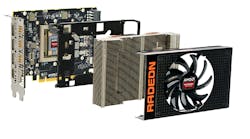Gaming is all about performance, but there have been few gains on the CPU side. Game developers are taking advantage of multiple CPU cores in the latest processors as the number has been increasing, but the performance of the individual cores has been relatively flat for the past few years. The challenge is that the CPU cores are large, so providing a massive increase in core count is unlikely.
GPUs have similar challenges, but there are a number of factors that have allowed growth of graphics performance. Increasing the number of cores has been more practical than with CPUs, and features like high bandwidth memory help as well.
AMD’s compact R9 Nano (Fig. 1) highlights the improvements that GPUs have been going through for the past few years. The R9 Nano incorporates on-chip, 4096-bit wide, high-bandwidth-memory (HBM) to feed the 4096 stream processors in the 28-nm Fiji GPU. The board only uses 175 W versus the 300 W of high-end, full-length boards.
HBM puts a 3D DRAM memory stack on top of a silicon interposer layer along with the GPU die. It does a couple of things. First, it provides a wider interface than would be practical for off-chip memory. Second, it brings the memory closer to the GPU cores. Third, it provides a more power-efficient memory subsystem. Finally, it is a more compact solution compared to off-chip memory.
This R9 Nano HBM implementation has four die stacks with two 128-bit memory channels per die (Fig. 2). This provides a 1024-bit channel. Four stacks provides the 4096-bit bus. The stacks are also found in the longer but more powerful Fury and liquid-cooled Fury X GPU boards, also from AMD. These deliver top-end gaming performance to multiple displays.
The R9 Nano and its siblings support Microsoft DirectX 12 and Microsoft Windows 10. DirectX 12 includes a host of new features, including Explicit Multiadapter support for multiple GPU solutions. This could be multiple GPU boards or to take advantage of a CPU/GPU combination like Intel’s latest Silverlake as well as AMD’s Accelerated Processing Unit (APU) in combination with a GPU board like the R9 Nano (see “APU Blends Quad Core x86 With 384 Core GPU” on electronicdesign.com). DirectX 12 is the target for the latest crop of PC games. It is also providing a more efficient link to the underlying hardware.
So if you are looking to improve your gaming system, then don’t worry if your motherboard and processor are a few years old. Instead, take a look at replacing your GPU. If you are building a new platform, then you might save a few dollars using an older processor chip with a few more cores.


